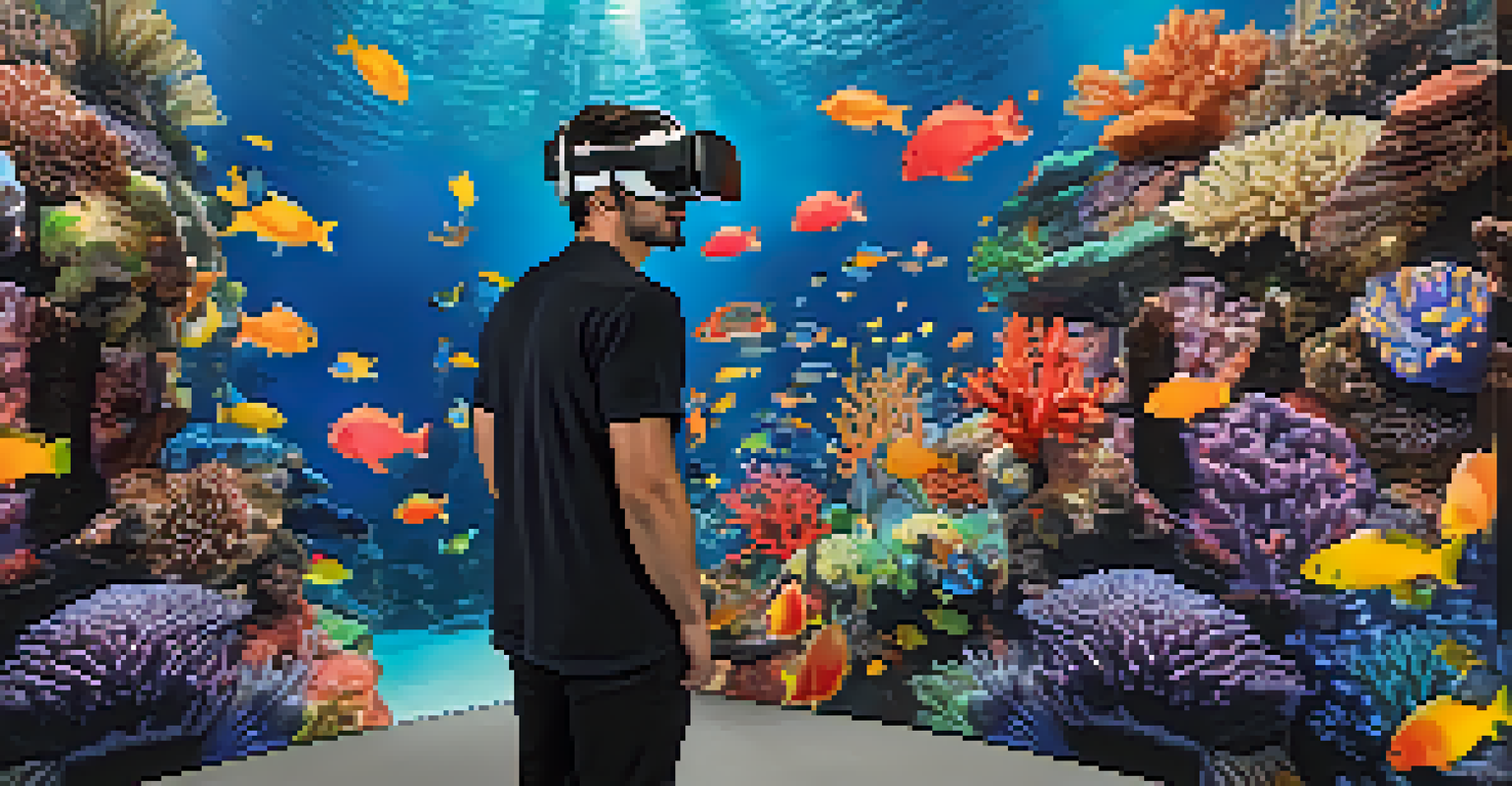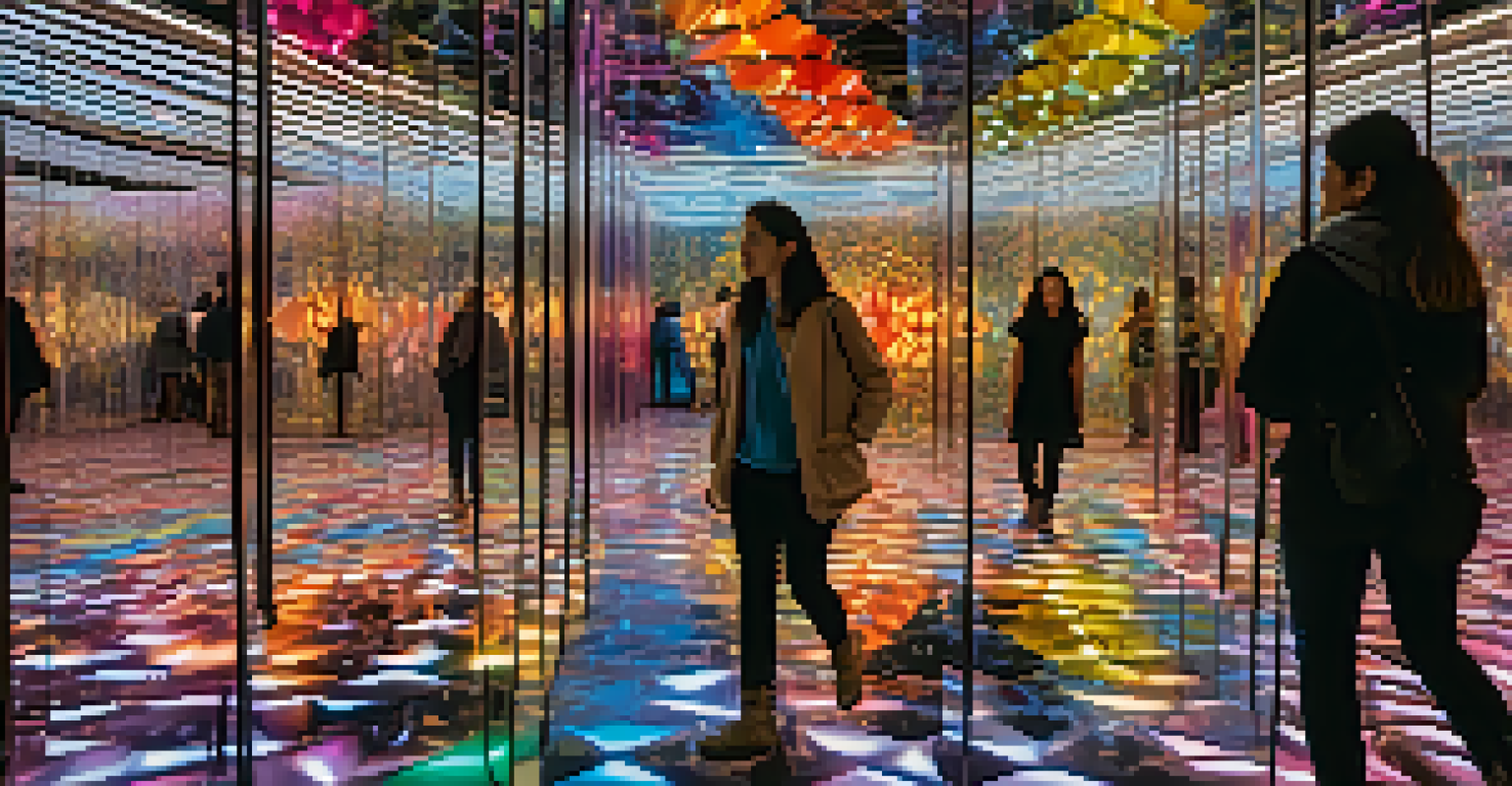Creating Immersive Experiences: Multi-Sensory Art Installations

Understanding Multi-Sensory Art Installations
Multi-sensory art installations are unique artistic expressions that engage multiple senses simultaneously. Unlike traditional art forms that may focus primarily on sight, these installations invite visitors to experience art through sound, touch, smell, and even taste. This immersive approach creates a deeper emotional connection, allowing the audience to engage not just visually, but in a holistic way.
Art is not what you see, but what you make others see.
Imagine walking into a dimly lit room filled with soft, ambient sounds of nature, the scent of fresh pine, and a gentle breeze created by strategically placed fans. This multi-sensory experience transports you to a serene forest, merging art with the environment. Artists aim to break away from conventional viewing experiences, pushing boundaries to evoke feelings and memories through a well-rounded sensory journey.
By integrating various sensory elements, artists can enhance storytelling, leaving a lasting impact on their audience. As technology evolves, so do the possibilities for creating these installations, allowing for even more innovative experiences that captivate and inspire.
The Role of Technology in Art Installations
Technology plays a crucial role in the evolution of multi-sensory art installations. From virtual reality (VR) to augmented reality (AR), artists are harnessing cutting-edge tools to create immersive environments that were once unimaginable. For instance, a VR installation might transport you to the depths of the ocean, allowing you to hear the sounds of marine life while seeing vibrant coral reefs.

Soundscapes, created using advanced audio technology, can envelop visitors, enhancing their emotional responses. This incorporation of tech not only enriches the sensory experience but also provides artists with more freedom to explore unconventional themes and narratives. The result is a dynamic interplay of art and technology, where each enhances the other.
Multi-Sensory Art Engages All Senses
Multi-sensory art installations invite audiences to engage through sight, sound, touch, smell, and taste, fostering a deeper emotional connection.
Moreover, interactive elements allow audiences to become part of the artwork itself. This participation fosters a sense of ownership and connection, making the experience personal and memorable. As technology continues to evolve, the potential for multi-sensory installations will only grow, inviting more diverse and imaginative expressions.
Creating Emotional Connections Through Art
At the heart of multi-sensory art installations is the desire to create emotional connections with the audience. By engaging multiple senses, artists can evoke powerful memories and feelings that resonate with viewers on a personal level. For example, a fragrance reminiscent of childhood can transport someone back to a specific moment in time, creating a sense of nostalgia.
The best artist has no conception that a marble block does not contain within it, but only how to carve it.
These emotional connections often stem from shared human experiences, such as joy, sorrow, or wonder. By tapping into these universal themes, artists can create an inclusive space where everyone can find something relatable. This is why many installations invite visitors to interact or contribute, making the experience even more communal and impactful.
The emotions stirred by these installations can lead to profound reflections and conversations. As people navigate through these sensory journeys, they may find themselves contemplating their own life stories and experiences, fostering a deeper understanding of both themselves and others.
Examples of Iconic Multi-Sensory Installations
One of the most iconic multi-sensory art installations is Yayoi Kusama's Infinity Mirror Rooms. These installations utilize mirrors and lights to create an illusion of endless space, enveloping visitors in a kaleidoscope of colors and reflections. The experience is not just visual; it evokes feelings of infinity and transcendence, making it a memorable journey for all who enter.
Another notable example is teamLab's Borderless exhibition, where digital art interacts with visitors in real-time. As people move through the space, the artwork changes, incorporating their movements and creating a unique experience for each person. This fusion of art, technology, and interactivity exemplifies the power of multi-sensory installations to engage and captivate.
Technology Enhances Artistic Experience
Advancements in technology, such as VR and interactive elements, allow artists to create immersive environments that captivate and inspire audiences.
These installations demonstrate how art can break traditional barriers and create a dialogue between the audience and the artwork. They serve as a testament to the creativity and innovation inherent in the world of multi-sensory art, inspiring future artists to push the limits of their own installations.
The Impact of Multi-Sensory Experiences on Audience Engagement
Multi-sensory experiences have a profound impact on audience engagement, often leading to deeper interaction and involvement. When visitors are encouraged to use all their senses, they become active participants rather than passive observers. This shift transforms the way people perceive and appreciate art, fostering a connection that can be both personal and communal.
Engagement levels tend to rise when visitors feel a sense of agency within the installation. For example, installations that allow people to manipulate sound or light can make them feel more invested in the experience. This active participation encourages exploration and play, creating a joyful and memorable atmosphere.
As a result, these immersive experiences often lead to more meaningful conversations about the artwork. People are likely to share their impressions, feelings, and interpretations, enriching the overall experience for everyone. This engagement creates a community around the art, turning a solitary experience into a shared journey.
Challenges in Creating Multi-Sensory Installations
While multi-sensory art installations offer remarkable opportunities, they also come with their unique challenges. One significant hurdle is the need for careful planning and coordination among various sensory elements. Artists must consider how each sense will interact and complement one another, ensuring a harmonious experience that doesn’t overwhelm or confuse the audience.
Another challenge is accessibility. It's essential for installations to be inclusive for all audiences, including those with sensory sensitivities or disabilities. This requires thoughtful design choices that consider how different individuals will engage with each element of the installation, creating an experience that everyone can enjoy.
Emotional Connections Foster Community
By evoking shared human experiences, multi-sensory installations encourage personal reflections and create a communal atmosphere around art.
Lastly, the reliance on technology can pose its own set of issues. Technical glitches or malfunctions can disrupt the experience and detract from the intended impact of the artwork. Artists and curators must be prepared to address these potential hiccups, ensuring that the immersive experience remains seamless and enjoyable for all.
The Future of Multi-Sensory Art Installations
The future of multi-sensory art installations is bright and full of potential. As technology continues to advance, artists will have even more tools at their disposal to create innovative and engaging experiences. The integration of artificial intelligence, virtual reality, and other emerging technologies will likely push the boundaries of what is possible in the realm of art.
Moreover, as society increasingly values experiences over material possessions, multi-sensory installations will become more sought after. People crave unique, memorable experiences that resonate with them, and these installations offer exactly that. This shift in consumer preferences will encourage more artists to explore multi-sensory approaches in their work.

Ultimately, the evolution of multi-sensory art installations will continue to foster deeper connections between art and audiences. By breaking down barriers and inviting participation, these installations will not only enhance the appreciation of art but also inspire future generations of artists to innovate and explore the endless possibilities of multi-sensory engagement.